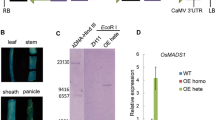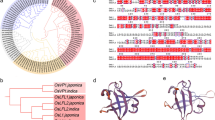Abstract
Rice (Oryza sativa L.) is one of the most important food crops, especially in Asia. The spikelet is a characteristic structure of grass inflorescences that determines crop output. However, the molecular mechanism that controls spikelet development and grain yield in rice remains unclear. In this study, we isolated a new osmads34 allelic mutant (i.e., osmads34-t). The osmads34-t mutant showed more primary branch numbers, short panicles, and long sterile lemmas. The sterile lemmas were transformed into the lemmas and had the lemma identity in the osmads34-t mutant, suggesting that the sterile lemma and lemma are homologous organs. Additionally, osmads34-t displayed smaller grains on its secondary branches of panicles and a lower seed-setting rate. These results suggest that OsMADS34 plays an important role in determination of grain size and yield in rice. OsMADS34 was expressed in tested organs and tissues, and its green fluorescent protein (GFP) signal was located in the nucleus. The result of this study will be used to understand the identity of unique organs in grass spikelets and may improve grain yield in breeding practice.






Similar content being viewed by others
Reference
Abacar JD, Lin ZM, Zhang XC, Ding CQ, Tang S, Liu ZH, Wang SH, Ding YF (2016) Variation in yield and physicochemical quality traits among mutants of japonica rice cultivar Wuyujing 3. Rice Sci 23(1):33–41
Bart R, Chern M, Park CJ, Bartley L, Ronald PC (2006) A novel system for gene silencing using siRNAs in rice leaf and stem-derived protoplasts. Plant Methods 2:13
Coen ES, Meyerowitz EM (1991) The war of the whorls: genetic interactions controlling flower development. Nature 353(6339):31–37
Dreni L, Pilatone A, Yun D, Erreni S, Pajoro A, Caporali E, Zhang DB, Kater MM (2011) Functional analysis of all AGAMOUS subfamily members in rice reveals their roles in reproductive organ identity determination and meristem determinacy. Plant Cell 23(8):2850–2863
Duan PG, Rao YC, Zeng DL, Yang YL, Xu R, Zhang BL, Dong GJ, Qian Q, Li YH (2014) SMALL GRAIN 1, which encodes a mitogen-activated protein kinase 4, influences grain size in rice. Plant J 77(4):547–557
Fan CC, Xing YZ, Mao HL, Lu TT, Han B, Xu CG, Li XH, Zhang QF (2006) GS3, a major QTL for grain length and weight and minor QTL for grain width and thickness in rice, encodes a putative transmembrane protein. Theor Appl Gene 112(6):1164–1171
Gao XC, Liang WQ, Yin CS, Ji SM, Wang HM, Su X, Guo CC, Kong HZ, Xue HW, Zhang DB (2010) The SEPALLATA-like gene OsMADS34 is required for rice inflorescence and spikelet development. Plant Physiol 153(2):728–740
Guo LB, Gao ZY, Qian Q (2014) Application of resequencing to rice genomics, functional genomics and evolutionary analysis. Rice 7(1):1–10
Hong LL, Qian Q, Zhu KM, Tang D, Huang ZJ, Gao L, Li M, Gu MH, Cheng ZK (2010) ELE restrains empty glumes from developing into lemmas. J Genet Genomics 37(2):101–115
Hong Z, Ueguchi-Tanaka M, Umemura K, Uozu S, Fujioka S, Takatsuto S, Yoshida S, Ashikari M, Kitano H, Matsuoka M (2003) A rice brassinosteroid-deficient mutant, ebisu dwarf (d2), is caused by a loss of function of a new member of cytochrome P450. Plant Cell 15(12):2900–2910
Hu J, Wang YX, Fang YX, Zeng LJ, Xu J, Yu HP, Shi ZY, Pan JJ, Zhang D, Kang SJ, Zhu L, Dong GJ, Guo LB, Zeng DL, Zhang GH, Xie LH, Xiong GS, Li JY, Qian Q (2015) A rare allele of GS2 enhances grain size and grain yield in rice. Mol Plant 8(10):1455–1465
Huang XZ, Qian Q, Liu ZB, Sun HY, He SY, Luo D, Xia GM, Chu CC, Li JY, Fu XD (2009) Natural variation at the DEP1 locus enhances grain yield in rice. Nat Genet 41(4):494–497
Ikeda K, Sunohara H, Nagato Y (2004) Developmental course of inflorescence and spikelet in rice. Breeding Sci 54:147–156
Kellogg EA (2009) The evolutionary history of Ehrhartoideae, Oryzeae, and Oryza. Rice 2(1):1–14
Khanday I, Yadav SR, Vijayraghavan U (2013) Rice LHS1/OsMADS1 controls floret meristem specification by coordinated regulation of transcription factors and hormone signaling pathways. Plant Physiol 161(4):1970–1983
Kobayashi K, Maekawa M, Miyao A, Hirochika H, Kyozuka J (2010) PANICLE PHYTOMER2 (PAP2), encoding a SEPALLATA subfamily MADS-box protein, positively controls spikelet meristem identity in rice. Plant Cell Physiol 51(1):47–57
Kobayashi K, Yasuno N, Sato Y, Yoda M, Yamazaki R, Kimizu M, Yoshida H, Nagamura Y, Kyozuka J (2012) Inflorescence meristem identity in rice is specified by overlapping functions of three AP1/FUL-like MADS box genes and PAP2, a SEPALLATA MADS box gene. Plant Cell 24(5):1848–1859
Li F, Liu WB, Tang JY, Chen JF, Tong HN, Hu B, Li CL, Fang J, Chen MS, Chu C (2010) Rice DENSE AND ERECT PANICLE 2 is essential for determining panicle outgrowth and elongation. Cell Res 20(7):838–849
Li HF, Liang WQ, Hu Y, Zhu L, Yin CS, Xu J, Dreni L, Kater MM, Zhang DB (2011) Rice MADS6 interacts with the floral homeotic genes SUPERWOMAN1, MADS3, MADS58, MADS13, and DROOPING LEAF in specifying floral organ identities and meristem fate. Plant Cell 23(7):2536–2552
Li H, Xue DW, Gao ZY, Yan MX, Xu WY, Xing Z, Huang DN, Qian Q, Xue YB (2009) A putative lipase gene EXTRA GLUME1 regulates both empty-glume fate and spikelet development in rice. Plant J 57(4):593–605
Lu SJ, Wei H, Wang Y, Wang HM, Yang RF, Zhang XB, Tu JM (2012) Over expression of a transcription factor OsMADS15 modifies plant architecture and flowering time in rice (Oryza sativa L.). Plant Mol Biol Rep 30(6):1461–1469
Miura K, Agetsuma M, Kitano H, Yoshimura A, Matsuoka M, Jacobsen SE, Ashikari M (2009) A metastable DWARF1 epigenetic mutant affecting plant stature in rice. P Natl Acad Sci USA 106(27):11218–11223
Mori M, Nomura T, Ooka H, Ishizaka M, Yokota T, Sugimoto K, Okabe K, Kajiwara H, Satoh K, Yamamoto K, Hirochika H, Kikuchi S (2002) Isolation and characterization of a rice dwarf mutant with a defect in brassinosteroid biosynthesis. Plant Physiol 130(3):1152–1161
Nakagawa H, Tanaka A, Tanabata T, Ohtake M, Fujioka S, Nakamura H, Ichikawa H, Mori M (2011) SHORT GRAIN1 decreases organ elongation and brassinosteroid response in rice. Plant Physiol 158(3):1208–1219
Prasad K, Parameswaran S, Vijayraghavan U (2005) OsMADS1, a rice MADS-box factor, controls differentiation of specific cell types in the lemma and palea and is an early-acting regulator of inner floral organs. Plant J 43(6):915–928
Qi P, Lin YS, Song XJ, Shen JB, Huang W, Shan JX, Zhu MZ, Jiang LW, Gao JP, Lin HX (2012) The novel quantitative trait locus GL3.1 controls rice grain size and yield by regulating cyclin-T1;3. Cell Res 22(12):1666–1680
Qian Q, Guo LB, Smith SM, Li JY (2016) Breeding high-yield superior-quality hybrid super-rice by rational design. Natl Sci Rev. doi:10.1093/nsr/nww006
Ren DY, Li YF, Zhao FM, Sang XC, Shi JQ, Wang N, Guo S, Ling YH, Zhang CW, Yang ZL, He GH (2013) MULTI-FLORET SPIKELET1, which encodes an AP2/ERF protein, determines spikelet meristem fate and sterile lemma identity in rice. Plant Physiol 162(2):872–884
Ren DY, Rao YC, Wu LW, Xu QK, Li ZZ, Yu HP, Zhang Y, Leng YJ, Hu J, Zhu L, Gao ZY, Dong GJ, Zhang GH, Guo LB, Zeng DL, Qian Q (2015) The pleiotropic ABNORMAL FLOWER AND DWARF1 affects plant height, floral development and grain yield in rice. J Integr Plant Biol 58(6):529–539
Sieburth LE, Meyerowitz EM (1997) Molecular dissection of the AGAMOUS control region shows that cis elements for spatial regulation are located intragenically. Plant Cell 9(3):355–365
Song XJ, Huang W, Shi M, Zhu MZ, Lin HX (2007) A QTL for rice grain width and weight encodes a previously unknown RING-type E3 ubiquitin ligase. Nat Genet 39(5):623–630
Wang JY, Nakazaki T, Chen SQ, Chen WF, Saito H, Tsukiyama T, Okumoto Y, Xu Z, Tanisaka T (2009) Identification and characterization of the erect-pose panicle gene EP conferring high grain yield in rice (Oryza sativa L.). Theor Appl Gene 119(1):85–91
Wang SK, Li S, Liu Q, Wu K, Zhang JQ, Wang SS, Wang Y, Chen XB, Zhang Y, Gao CX, Wang F, Huang HX, Fu XD (2015a) The OsSPL16-GW7 regulatory module determines grain shape and simultaneously improves rice yield and grain quality. Nat Genet 47(8):949–954
Wang YX, Xiong GS, Hu J, Jiang L, Yu H, Xu J, Fang YX, Zeng JL, Xu EB, Xu J, Ye WJ, Meng XB, Liu RF, Chen HQ, Jing YH, Wang YH, Zhu XD, Li JY, Qian Q (2015b) Copy number variation at the GL7 locus contributes to grain size diversity in rice. Nat Genet 47(8):944–948
Weng JF, Gu SH, Wan XY, Gao H, Guo T, Su N, Lei CL, Zhang X, Cheng ZJ, Guo XP, Wang JL, Jiang L, Zhai HQ, Wan JM (2008) Isolation and initial characterization of GW5, a major QTL associated with rice grain width and weight. Cell Res 18(12):1199–1209
Wu LW, Ren DY, Hu SK, Li GM, Dong GJ, Jiang L, Hu XM, Ye WJ, Cui YT, Zhu L, Hu J, Zhang GH, Gao ZY, Zeng DL, Qian Q, Guo LB (2016) Down-regulation of a nicotinate phosphoribosyltransferase gene, OsNaPRT1, leads to withered leaf tips. Plant Physiol 171(2):1085–1098
Xing YZ, Zhang QF (2010) Genetic and molecular bases of rice yield. Annu Rev Plant Biol 61:421–442
Xu CJ, Liu Y, Li YB, Xu XD, Xu CG, Li XH, Xiao JH, Zhang QF (2015) Differential expression of GS5 regulates grain size in rice. J Exp Bot 66(9):2611–2623
Yamamuro C, Ihara Y, Wu X, Noguchi T, Fujioka S, Takatsuto S, Ashikari M, Kitano H, Matsuoka M (2000) Loss of function of a rice brassinosteroid insensitive1 homolog prevents internode elongation and bending of the lamina joint. Plant Cell 12(9):1591
Yang XL, Wu F, Lin XL, Du XQ, Chong K, Gramzow L, Schilling S, Becker A, Theißen G, Meng Z (2012) Live and let die—the Bsister MADS-box gene OsMADS29 controls the degeneration of cells in maternal tissues during seed development of rice (Oryza sativa). PLoS One 7(12):e51435
Yin LL, Xue HW (2012) The MADS29 transcription factor regulates the degradation of the nucellus and the nucellar projection during rice seed development. Plant Cell 24(3):1049–1065
Yoshida A, Suzaki T, Tanaka W, Hirano HY (2009) The homeotic gene long sterile lemma (G1) specifies sterile lemma identity in the rice spikelet. P Natl Acad Sci USA 106(47):20103–20108
Yoshida H, Nagato Y (2011) Flower development in rice. J Exp Bot 62(14):4719–4730
Yu HP, Ren DY, Zhu YZ, Xu JM, Wang YX, Liu RF, Fang YX, Shi ZY, Pan JJ, Lu M, Ma BJ, Hu J, Rao YC (2015) MULTI-TILLERING DWARF1, a new allele of BRITTLE CULM 12, affects plant height and tiller in rice. Sci Bull. doi:10.1007/s11434-015-0981-y
Zhang D, Yuan Z (2014) Molecular control of grass inflorescence development. Annu Rev Plant Biol 65:553–578
Zuo JR, Li JY (2014) Molecular genetic dissection of quantitative trait loci regulating rice grain size. Annu Rev Genet 48:99–118
Acknowledgments
This research was supported by the Major Project of Education Department in Liaoning (No. LSNZD201605) and the Program for Changjiang Scholars and Innovative Research Team in University (No. IRT13079).
Author information
Authors and Affiliations
Corresponding author
Additional information
Yu Zhang and Haiping Yu are equal contributors
Rights and permissions
About this article
Cite this article
Zhang, Y., Yu, H., Liu, J. et al. Loss of function of OsMADS34 leads to large sterile lemma and low grain yield in rice (Oryza sativa L.). Mol Breeding 36, 147 (2016). https://doi.org/10.1007/s11032-016-0578-4
Received:
Accepted:
Published:
DOI: https://doi.org/10.1007/s11032-016-0578-4




